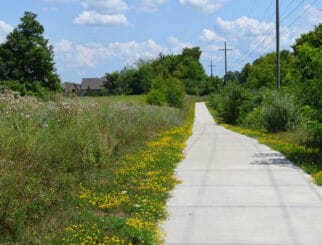East Riverwalk 3D Scanning – Uniroyal Site
The Project
Spalding DeDecker provided professional surveying services for the portion of the East Riverwalk that travels across the old Uniroyal site and under the MacArthur Bridge to Gabriel Richard Park. The survey was to be performed according to the Michigan Department of Transportation Design Standards & Practices.
Our Services
Spalding DeDecker provided:
- Control surveys that would tie together previous projects along the Riverwalk
- 3D scanning of the MacArthur Bridge at the northeasterly riverbank
- Harbor line establishment
- Topographic mapping
- Boundary survey of the Uniroyal site
Spalding DeDecker combined 3D point cloud mapping, 3D bathymetric mapping, and conventional topographic mapping to create a complete three-dimensional survey.
The Challenge
The control survey consisted of horizontally and vertically tying together previous Riverwalk projects such as the Dequindre Cut, Chene Park, Rivertown, and Gabriel Richard Park. This task required detailed research and field control monumentation reconnaissance. The control for these projects was established over the past twenty years, and a substantial amount of construction had occurred during that time. Locating existing control and mapping the overgrown Uniroyal site would be difficult.
The Solution
Spalding DeDecker opted to use multiple survey technologies to deliver detailed 3D datasets for different tasks needed to complete this project.
Once the control survey was completed, our efforts were concentrated on 3D scanning the existing seawall and the bathymetric scanning. By combining 3D river bottom data, terrestrial scanning data, and conventional data, it gave the design engineer a complete and accurate perspective of the existing site conditions including the river bottom, bridge piers, rip rap, and the underside of the arched bridge beams.
The Impact
Our 3D laser scanning of the seawall and the underside of the bridge allowed the engineers to identify height clearance and rip rap area safety. The underside of the bridge beams is unique as they are curved on a changing radius that affects the height clearances along the proposed Riverwalk. The combination of the terrestrial scanning and bathymetric scanning was used in the design of new seawalls and to identify any shoring issues of the existing bridge piers.


